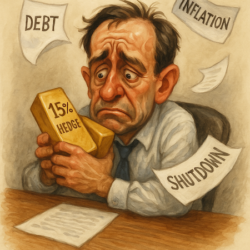Publisher’s Note: For the most part, US president, is delivering what he promised – an ‘America First’ set of policies. For that reason, it’s difficult to fathom why so many are shocked by it.
The market’s reaction suggests that most investors (including the ‘big guys’ on Wall Street) didn’t believe Trump would do what he promised. Arguably, that’s part of the reason why Trump won, because folks were fed up with lying politicians.
In today’s essay, Jim Rickards explains the core foundation behind Trump’s plan. It’s the ‘American System’. To understand what’s in store for the future, this essay is the beset place to start…
Donald Trump is back in the White House.
And while the Oval Office may seem far removed from Westminster, British investors would be wise to pay attention—because the ripple effects of Trump’s economic agenda will stretch far beyond U.S. borders.
We’re entering a new cycle of tariff wars, industrial reshoring, and energy realignment. For UK portfolios with exposure to global markets—or companies that trade with or operate in the U.S.—this shift could bring both risk and opportunity.
The question is whether your portfolio is positioned to benefit.
Because Trump’s second term isn’t a repeat of his first.
It’s more focused. More aggressive. And already accelerating the return of an economic playbook that reshaped America in the past—and could do so again: the American System.
Here’s what you need to know…
The Revival of the American System
Under the guidance of Trump advisors Robert Lighthizer (former U.S. Trade Representative) and Peter Navarro (former Director of the Office of Trade and Manufacturing Policy), Trump is pursuing a twenty-first-century version of what was originally known as the American System.
The American System was invented in 1790 by Alexander Hamilton and supported by a succession of U.S. presidents and leading political figures including George Washington, Henry Clay, John Quincy Adams, Abraham Lincoln, William McKinley, Calvin Coolidge, and Dwight Eisenhower.
There were opponents who favored agrarian interests over manufacturing interests, including early members of what later became the Democratic Party such as Thomas Jefferson, James Madison and James Monroe. Yet, their financial failures, including the liquidation of the First Bank of the United States (an early central bank with limited powers) and difficulties in financing the War of 1812 led to the success of the mercantilist and manufacturing programs of the American System leaders.
The American System relied on the following policies:
- High tariffs to support manufacturing and high-paying jobs
- Infrastructure investment (public and private) to support productivity
- A strong army and navy to protect the U.S. but not to fight foreign wars
- A central bank with limited powers to provide liquidity to commerce
To the extent there was government spending, it was for productive projects such as canal and road building and later to support railroads. To the extent that early central banks existed, they were for secure lending to sound entities (including the U.S. government) and not for purposes such as printing money, fixing interest rates or “stimulus.” The entire program could be summarized as sound money, smart investment and a strong military in the service of high-paying American jobs.
The American System prevailed from 1790 to 1962 with occasional periods of agrarian ascendency and some disruptions such as the Civil War.
Beginning after World War I, the neo-liberal movement of Austrian economists and libertarians began to promote globalist policies of open borders, open capital accounts, and free trade.
Of course, free trade is a myth because of subsidies and non-tariff barriers. Comparative advantage is obsolete because the factors of production are highly mobile.
Taiwan had no comparative advantage in semiconductors in 1979, but today they dominate global production. They made that happen through a Taiwanese version of the American System.
In contrast, the neo-liberals were living an ideological fantasy in which globalism was to displace sovereignty. At a minimum, their goal was the encasement of sovereigns in a larger orb of multilateral institutions such as the IMF, World Bank, WTO and the United Nations.
Beginning with the Trade Expansion Act of 1962, the Trade Act of 1974, and successive rounds under the General Agreement on Tariffs and Trade (today the WTO), the U.S. embraced the neo-liberal consensus including drastic tariff cuts. As jobs moved offshore to take advantage of cheap labor, capital followed as direct foreign investment.
The result was the hollowing-out of U.S. manufacturing, wage stagnation, slower growth, greater debt, and a succession of failed wars. The open border policy of Biden-Harris is consistent with neo-liberal views on the end of sovereignty but is a death knell for American jobs and social cohesion.
Trump, Lighthizer, Navarro, and others will return the United States to the pre-1962 glory days with the revival of the American System.
Foreign companies will be free to sell goods to Americans but only if they are manufactured in the U.S. This will lead to a wave of inbound investment in the U.S., a reduction in U.S. trade deficits, a stronger dollar (as the world demands dollars to invest here), and higher wages for U.S. workers. Higher wages will raise real incomes, stimulate consumption, decrease income inequality and expand the tax base to help reduce deficits without raising tax rates.
A Trump Portfolio
Sectors that will benefit from the return of the American System include:
Oil and natural gas drilling, production, and refining. This sector will benefit from Trump’s “drill, baby, drill” policies including increased leasing on Federal lands, increased offshore drilling, replenishment of the Strategic Petroleum Reserve, new pipelines, and expanded refinery capacity.
Mining (gold, silver, copper, lithium). Industrial metals will be in increased demand related to the expansion of U.S. manufacturing. Precious metals will be in demand as a hedge against geopolitical uncertainty and as a non-digital store of wealth.
Defense and National Security. This will especially benefit defense and intelligence contractors with extensive R&D programs. The U.S. does not need more obsolete weapons; we need newer and more sophisticated weapons to keep up with the high-tech systems that Russia is using. AI will be a valuable tool in intelligence analysis, especially from open sources (OSINT).
Automobile manufacturing. Foreign manufacturers will face huge tariffs. This will include Mexican manufacturers that are fronts for China. The United States-Mexico-Canada Agreement (USMCA) will be modified as needed to accommodate the tariffs.
Cryptocurrency plays. Trump will ease SEC and other regulatory constraints on cryptocurrency mining, distribution and use.
Banking and finance. As the economy grows, banks profit as intermediaries without the need for high leverage and high risk.
Trucking and airlines. These sectors will benefit from lower prices for refined products such as diesel and aviation fuel (basically kerosene).
Not every corner of the market will benefit from Trump’s return to power. In fact, some sectors are already under pressure.
Big Pharma and Big Agriculture face renewed scrutiny under Trump’s “Make America Healthy Again” agenda—an effort expected to be spearheaded by Robert F. Kennedy Jr. This could result in tighter controls, reduced subsidies, and regulatory shifts that weigh on margins.
Meanwhile, Elon Musk is leading a parallel push for government efficiency, which threatens bloated contractors in health care, education, and green energy. Expect deep cuts to programmes supporting EVs, wind, and solar projects—what critics have dubbed “the Green New Scam.”
ESG investing and DEI mandates are also in the firing line. These politically driven frameworks are falling out of favour fast, and funds heavily exposed to them—particularly those invested in China—could be caught on the wrong side of this new policy direction.
For British investors, this matters.
Many UK pension funds, ETFs, and institutional portfolios hold U.S. exposure in these sectors. ESG-driven strategies popular in the UK could face serious headwinds. And any UK firms reliant on U.S. green subsidies or healthcare contracts could see demand evaporate overnight.
The return of the American System isn’t just about reshoring U.S. industry. It’s a global reset in where capital flows and how policy drives profits.
Position accordingly.
Best,

Jim Rickards
Contributing Editor, Investor’s Daily




